Effects of Combined Usage of Supplementary Cementitious Materials on the Thermal Properties and Microstructure of High-Performance Concrete at High Temperatures
Abstract
:1. Introduction
2. Materials and Methods
2.1. Materials
2.2. Mixing Process
2.3. Testing Method
3. Results and Discussion
3.1. Thermal Conductivity
3.2. XRD Analysis
3.3. DTA Analysis
3.4. Microstructure Observations
4. Conclusions
- 1
- Combined usage of SCMs improved the high temperature resistance of concrete after subjected to high temperatures. Formation of the secondary gel and filling capacity by combined usage of SCMs, making the microstructure denser, can exclude propagation of cracks at high temperature.
- 2
- The thermal conductivity of both the reference concrete and HPC modified with SCMs increased slightly at 400 °C and reduced significantly at 800 °C. Thermal conductivity of concretes modified with SCMs was higher than that of the reference concrete. The thermal conductivity of the HPC modified with MK-UFFA and MK-UFFA-FA at 800 °C dropped to 0.3 W/(m·K) and 0.4 W/(m·K), respectively.
- 3
- The residual strength of concrete at 400 °C showed a slight increase due to the water result in the decomposition of some hydration products let to rehydrate the anhydrous cement particles. The internal structure cracked and damaged owing to the decomposition of C-S-H gel and CH at 600 °C. For the composite 20% FA-10% UFFA-5% MK mixture after heating to 1000 °C, the unreacted MK particles in the microstructure transformed to mullite as identified in the XRD patterns.
- 4
- The combined usage of SCMs to concrete contributes to the enhancement of high temperature resistance due to the generation of C-S-H gel and densification of the microstructure. FA not only could be prominently effective at concrete after exposure to high temperatures but works progressively alongside other pozzolanic materials, such as MK. Filling empty pores with different sizes and promoting pozzolanic reactions are two of the reasons that improved the high temperature resistance of concretes.
Author Contributions
Funding
Conflicts of Interest
References
- Drzymała, T.; Jackiewicz-Rek, W.; Tomaszewski, M.; Kuś, A.; Gałaj, J.; Šukys, R. Effects of High Temperature on the Properties of High Performance Concrete (HPC). Procedia Eng. 2017, 172, 256–263. [Google Scholar] [CrossRef]
- Molay, T.G.G.; Leroy, M.N.L.; Fidele, T.; Franck, H.G.; Bienvenu, N.J. Mechanical and Physical Performances of Concretes Made From Crushed Sands of Different Geological Nature Subjected to High Temperatures. Eng. Sci. Technol. Int. J. 2019, 22, 1116–1124. [Google Scholar] [CrossRef]
- Liang, X.; Wu, C.; Yang, Y.; Wu, C.; Li, Z. Coupled Effect of Temperature and Impact Loading On Tensile Strength of Ultra-High Performance Fibre Reinforced Concrete. Compos. Struct. 2019, 229, 111432. [Google Scholar] [CrossRef]
- Yang, J.; Peng, G.; Zhao, J.; Shui, G. On the Explosive Spalling Behavior of Ultra-High Performance Concrete with and without Coarse Aggregate Exposed to High Temperature. Constr. Build. Mater. 2019, 226, 932–944. [Google Scholar] [CrossRef]
- Zhu, P.; Brunner, S.; Zhao, S.; Griffa, M.; Leemann, A.; Toropovs, N.; Malekos, A.; Koebel, M.M.; Lura, P. Study of Physical Properties and Microstructure of Aerogel-Cement Mortars for Improving the Fire Safety of High-Performance Concrete Linings in Tunnels. Cem. Concr. Compos. 2019, 104, 103414. [Google Scholar] [CrossRef]
- Alonso, C.; Fernandez, L. Dehydration and Rehydration Processes of Cement Paste Exposed to High Temperature Environments. J. Mater. Sci. 2004, 39, 3015–3024. [Google Scholar] [CrossRef]
- Burciaga-Díaz, O.; Escalante-García, J.I. Comparative Performance of Alkali Activated Slag/Metakaolin Cement Pastes Exposed to High Temperatures. Cem. Concr. Compos. 2017, 84, 157–166. [Google Scholar] [CrossRef]
- Wang, W.; Lu, C.; Li, Y.; Li, Q. An Investigation on Thermal Conductivity of Fly Ash Concrete After high Temperature Exposure. Constr. Build. Mater. 2017, 148, 148–154. [Google Scholar] [CrossRef]
- Zhang, B. Effects of Moisture Evaporation (Weight Loss) On Fracture Properties of High Performance Concrete Subjected to High Temperatures. Fire Saf. J. 2011, 46, 543–549. [Google Scholar] [CrossRef]
- Manjunath, R.; Narasimhan, M.C.; Umesha, K.M. Studies on High Performance Alkali Activated Slag Concrete Mixes Subjected to Aggressive Environments and Sustained high Temperatures. Constr. Build. Mater. 2019, 229, 116887. [Google Scholar] [CrossRef]
- Zhao, J.; Zheng, J.; Peng, G.; van Breugel, K. Numerical Analysis of Heating Rate Effect On Spalling of High-Performance Concrete Under High Temperature Conditions. Constr. Build. Mater. 2017, 152, 456–466. [Google Scholar] [CrossRef]
- Awal, A.S.M.A.; Shehu, I.A.; Ismail, M. Effect of Cooling Regime On the Residual Performance of High-Volume Palm Oil Fuel Ash Concrete Exposed to High Temperatures. Constr. Build. Mater. 2015, 98, 875–883. [Google Scholar] [CrossRef]
- Lo Monte, F.; Felicetti, R.; Miah, M.J. The Influence of Pore Pressure on Fracture Behaviour of Normal-Strength and High-Performance Concretes at High Temperature. Cem. Concr. Compos. 2019, 104, 103388. [Google Scholar] [CrossRef]
- Saboo, N.; Shivhare, S.; Kori, K.K.; Chandrappa, A.K. Effect of Fly Ash and Metakaolin on Pervious Concrete Properties. Constr. Build. Mater. 2019, 223, 322–328. [Google Scholar] [CrossRef]
- Shehab El-Din, H.K.; Eisa, A.S.; Abdel Aziz, B.H.; Ibrahim, A. Mechanical Performance of High Strength Concrete Made From High Volume of Metakaolin and Hybrid Fibers. Constr. Build. Mater. 2017, 140, 203–209. [Google Scholar] [CrossRef]
- Peng, G.; Niu, X.; Shang, Y.; Zhang, D.; Chen, X.; Ding, H. Combined Curing as a Novel Approach to Improve Resistance of Ultra-High Performance Concrete to Explosive Spalling Under High Temperature and its Mechanical Properties. Cem. Concr. Res. 2018, 109, 147–158. [Google Scholar] [CrossRef]
- Stahl, T.; Brunner, S.; Zimmermann, M.; Ghazi Wakili, K. Thermo-Hygric Properties of a Newly Developed Aerogel Based Insulation Rendering for Both Exterior and Interior Applications. Energy Build. 2012, 44, 114–117. [Google Scholar] [CrossRef]
- Shen, D.; Jiao, Y.; Kang, J.; Feng, Z.; Shen, Y. Influence of Ground Granulated Blast Furnace Slag On Early-Age Cracking Potential of Internally Cured High Performance Concrete. Constr. Build. Mater. 2020, 233. [Google Scholar] [CrossRef]
- Anjos, M.A.S.; Camõ, A.; Campos, P.; Azeredo, G.A.; Ferreira, R.L.S. Effect of High Volume Fly Ash and Metakaolin with and without Hydrated Lime On the Properties of Self-Compacting Concrete. J. Build. Eng. 2020, 27. [Google Scholar] [CrossRef]
- Anwar Hossain, K.M. High Strength Blended Cement Concrete Incorporating Volcanic Ash: Performance at High Temperatures. Cem. Concr. Compos. 2006, 28, 535–545. [Google Scholar] [CrossRef]
- Karahan, O. Transport Properties of High Volume Fly Ash Or Slag Concrete Exposed to High Temperature. Constr. Build. Mater. 2017, 152, 898–906. [Google Scholar] [CrossRef]
- Morsy, M.S.; Al-Salloum, Y.A.; Abbas, H.; Alsayed, S.H. Behavior of Blended Cement Mortars Containing Nano-Metakaolin at high Temperatures. Constr. Build. Mater. 2012, 35, 900–905. [Google Scholar] [CrossRef]
- Zhou, J.; Lu, D.; Yang, Y.; Gong, Y.; Ma, X.; Yu, B.; Yan, B. Physical and Mechanical Properties of High-Strength Concrete Modified with Supplementary Cementitious Materials After Exposure to high Temperature Up to 1000 °C. Materials 2020, 13, 532. [Google Scholar] [CrossRef] [PubMed] [Green Version]
- Common Portland Cement (GB175-2007); China Architecture and Building Press: Beijing, China, 2007.
- Technical Code for Application of Mineral Admixture (GB/T 51003-2014); China Architecture and Building Press: Beijing, China, 2014.
- Sand for Construction (GB/T 14684-2011); China Architecture and Building Press: Beijing, China, 2011.
- Pebble and Crushed Stone for Construction (GB/T14685-2011); China Architecture and Building Press: Beijing, China, 2011.
- Pundienė, I.; Pranckevičienė, J. The Synergistic Effect of Adding a Blend of Deflocculants and Microsilica on the Properties of High Temperature Resistant Lightweight Concrete with Cenospheres. Constr. Build. Mater. 2020, 230, 116961. [Google Scholar] [CrossRef]
- Rashad, A.M. Potential Use of Phosphogypsum in Alkali-Activated Fly Ash Under the Effects of high Temperatures and Thermal Shock Cycles. J. Clean. Prod. 2015, 87, 717–725. [Google Scholar] [CrossRef]
- Abaeian, R.; Behbahani, H.P.; Moslem, S.J. Effects of High Temperatures on Mechanical Behavior of High Strength Concrete Reinforced with High Performance Synthetic Macro Polypropylene (HPP) Fibres. Constr. Build. Mater. 2018, 165, 631–638. [Google Scholar] [CrossRef]
- Xie, J.; Wang, J.; Rao, R.; Wang, C.; Fang, C. Effects of Combined Usage of GGBS and Fly Ash On Workability and Mechanical Properties of Alkali Activated Geopolymer Concrete with Recycled Aggregate. Compos. Part B Eng. 2019, 164, 179–190. [Google Scholar] [CrossRef]
- Lee, N.K.; Koh, K.T.; Park, S.H.; Ryu, G.S. Microstructural Investigation of Calcium Aluminate Cement-Based Ultra-High Performance Concrete (UHPC) Exposed to High Temperatures. Cem. Concr. Res. 2017, 102, 109–118. [Google Scholar] [CrossRef]


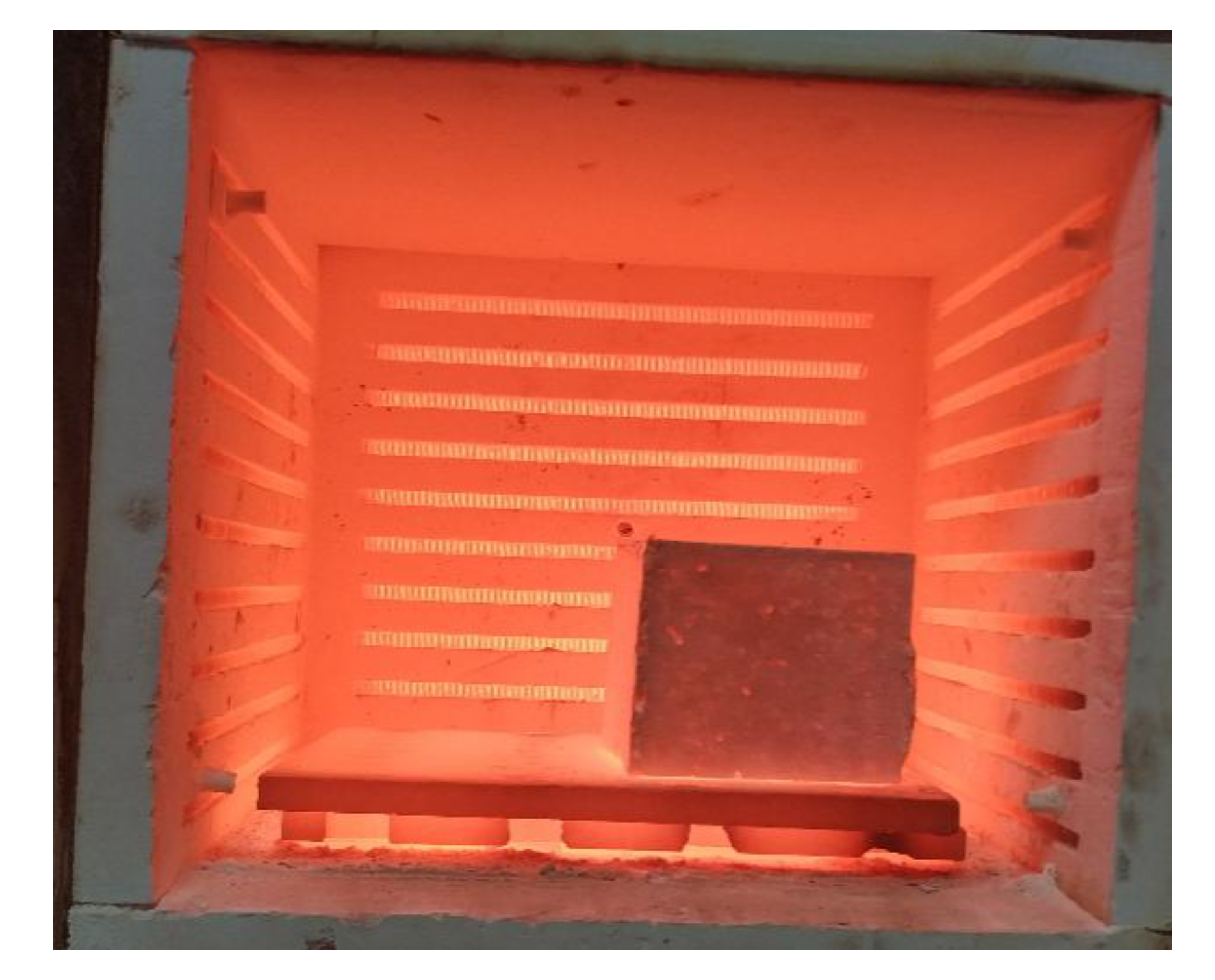
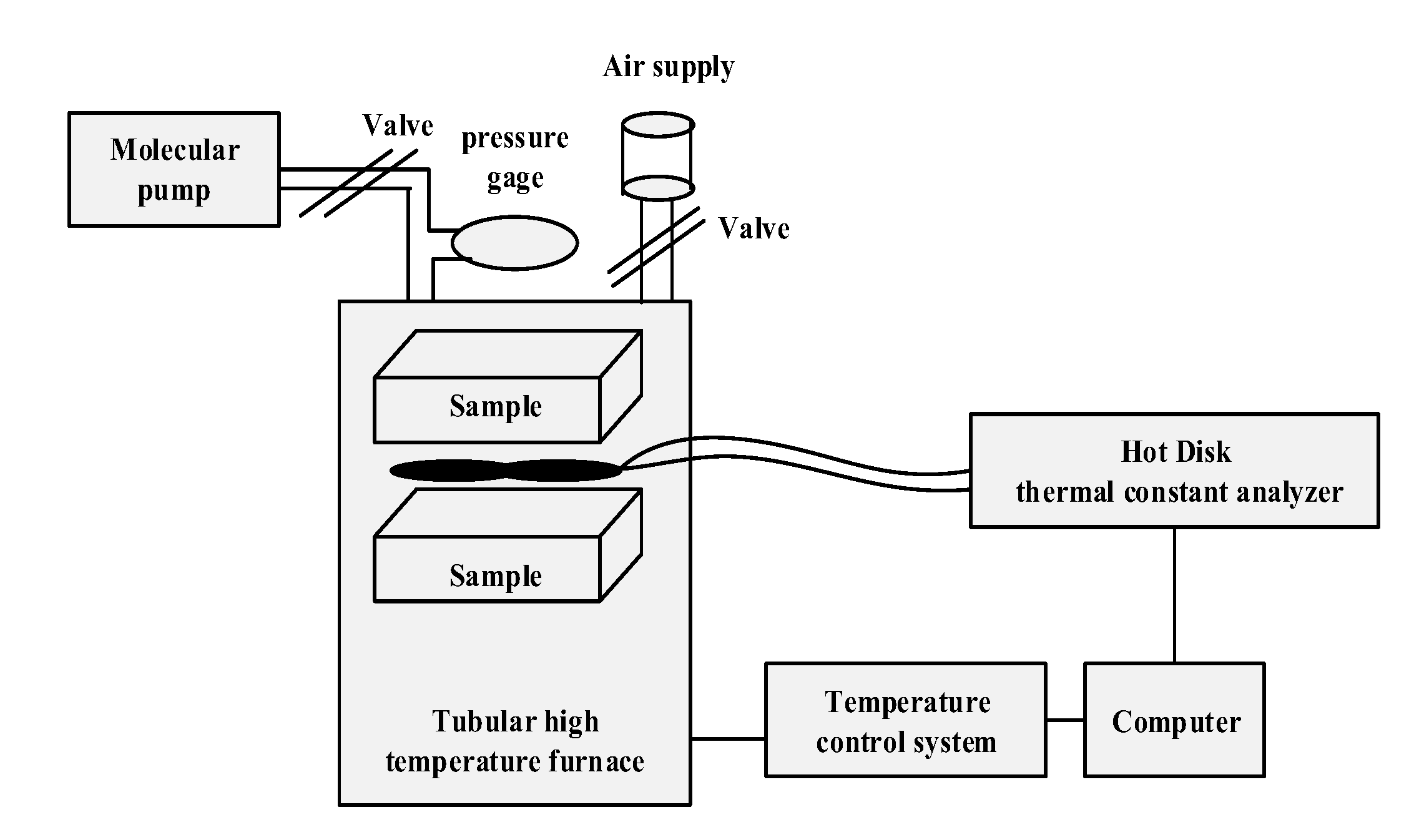
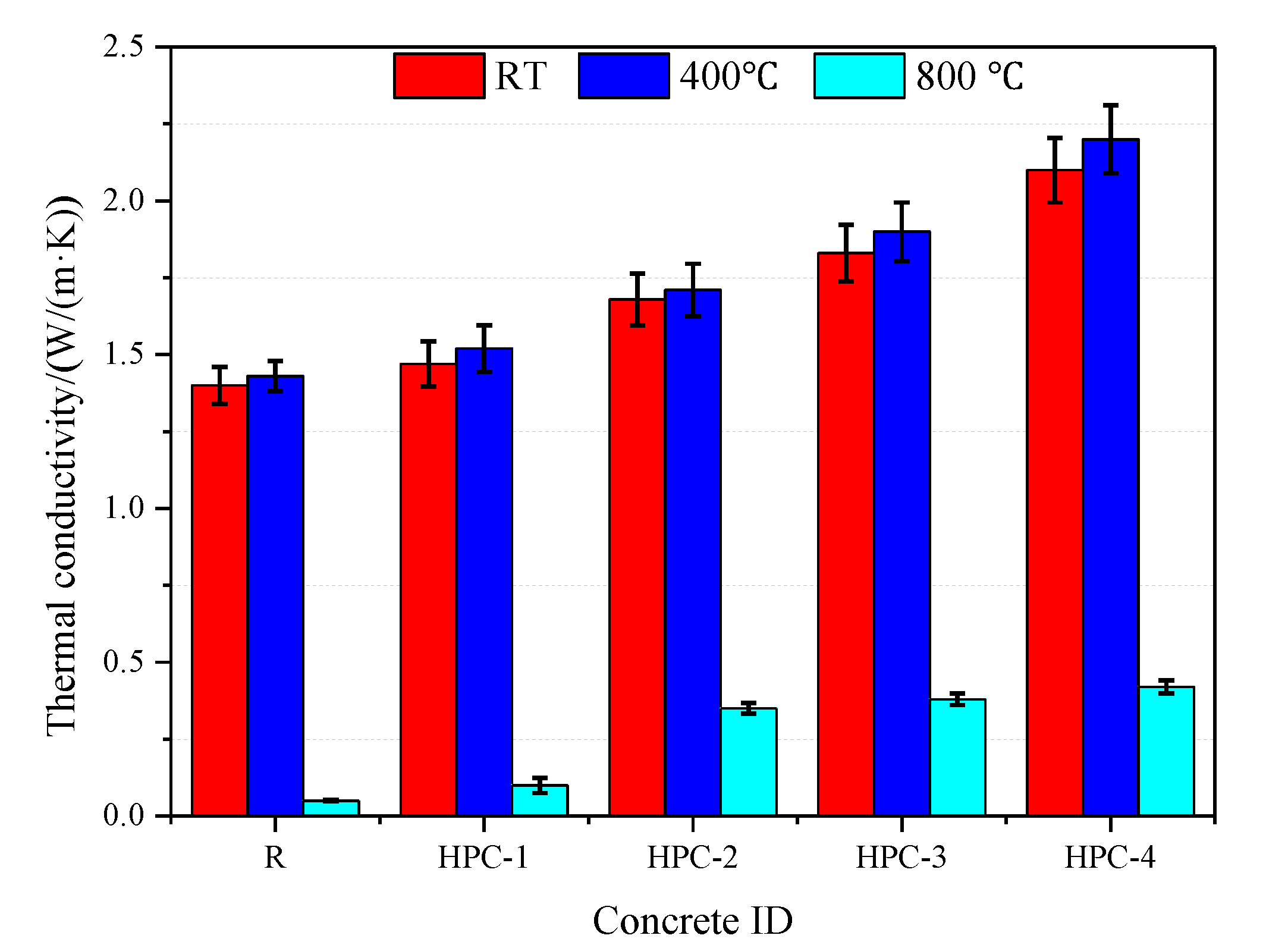
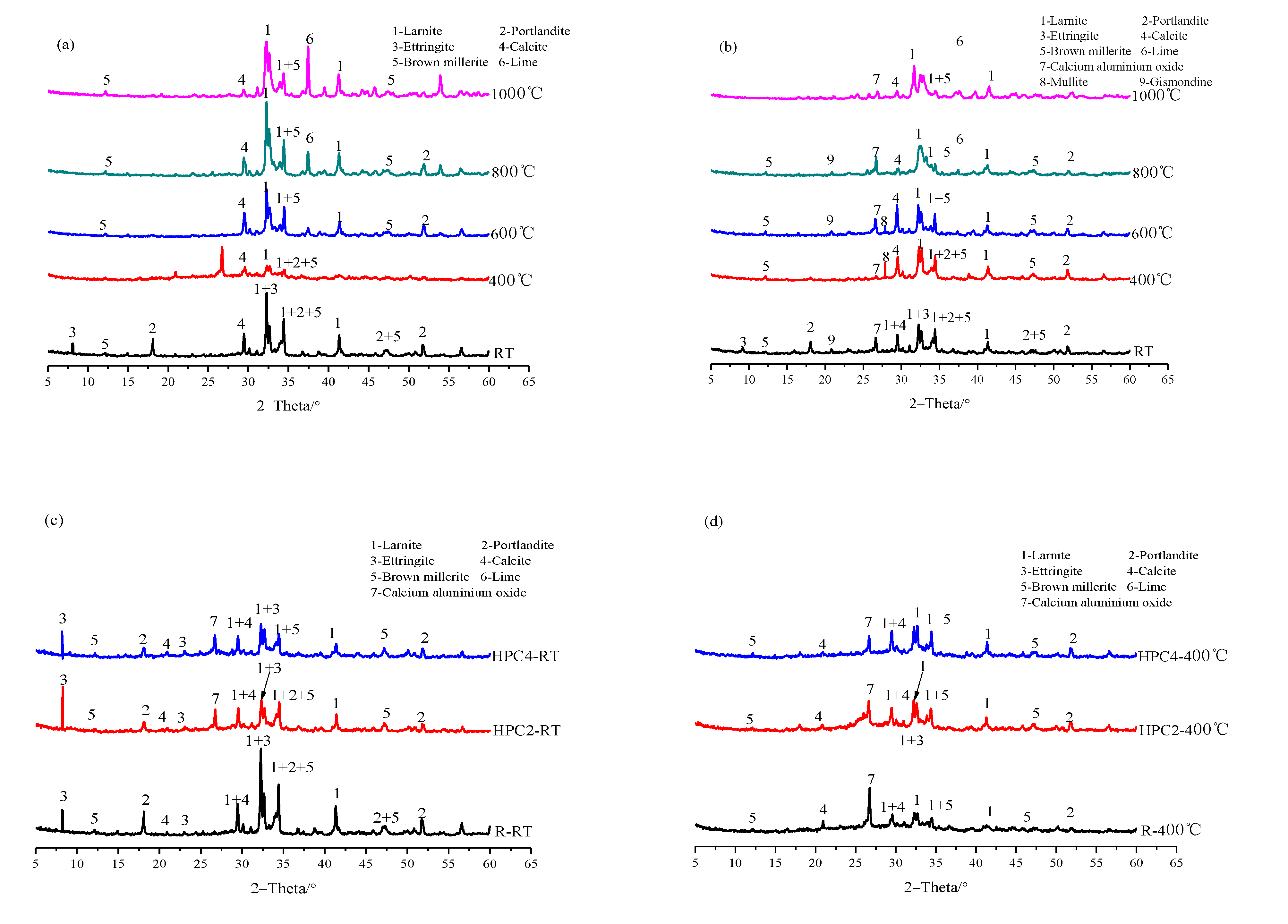
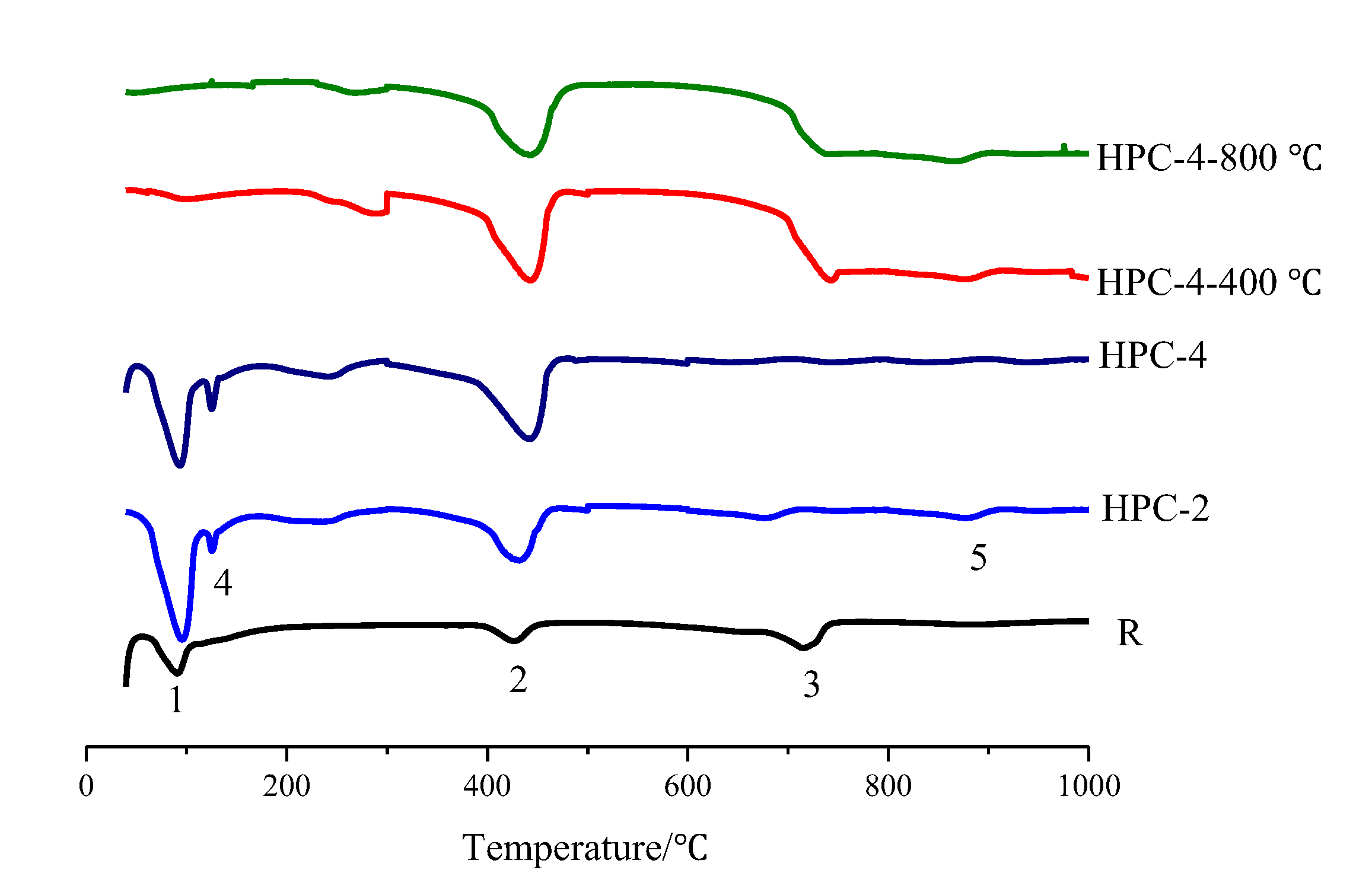

| Density (kg/cm3) | Specific surface properties (m2/kg) | Setting time (min) | Compressive strength (MPa) | Flexural strength (MPa) | |||
| Initial setting | Final setting | 3 d | 28 d | 3 d | 28 d | ||
| 3.06 | 461.2 | 115 | 150 | 28.6 | 60.1 | 5.6 | 9.1 |
| Sieve size (mm) | 16 | 9.5 | 4.75 | 2.36 | 1.18 | 0.6 | 0.3 | 0.15 | |
| Cumulative percentage retained, by mass (%) | Coarse | 0 | 12.5 | 87.8 | 98.2 | - | - | - | - |
| Fine | - | - | 3.1 | 15.7 | 22.1 | 43.2 | 88.4 | 96.8 | |
| Concrete ID | W/B | Cement | FA | UFFA | MK | Sand | Gravel | Water | SP |
|---|---|---|---|---|---|---|---|---|---|
| R | 0.21 | 600 | - | - | - | 634 | 1126 | 126 | 6 |
| HPC-1 | 0.21 | 480 | 120 | - | - | 634 | 1126 | 126 | 6 |
| HPC-2 | 0.21 | 420 | - | 180 | - | 634 | 1126 | 126 | 6 |
| HPC-3 | 0.21 | 390 | - | 180 | 30 | 634 | 1126 | 126 | 6 |
| HPC-4 | 0.21 | 390 | 60 | 120 | 30 | 634 | 1126 | 126 | 6 |
© 2020 by the authors. Licensee MDPI, Basel, Switzerland. This article is an open access article distributed under the terms and conditions of the Creative Commons Attribution (CC BY) license (http://creativecommons.org/licenses/by/4.0/).
Share and Cite
Lu, D.; Tang, Z.; Zhang, L.; Zhou, J.; Gong, Y.; Tian, Y.; Zhong, J. Effects of Combined Usage of Supplementary Cementitious Materials on the Thermal Properties and Microstructure of High-Performance Concrete at High Temperatures. Materials 2020, 13, 1833. https://doi.org/10.3390/ma13081833
Lu D, Tang Z, Zhang L, Zhou J, Gong Y, Tian Y, Zhong J. Effects of Combined Usage of Supplementary Cementitious Materials on the Thermal Properties and Microstructure of High-Performance Concrete at High Temperatures. Materials. 2020; 13(8):1833. https://doi.org/10.3390/ma13081833
Chicago/Turabian StyleLu, Dong, Zhuo Tang, Liang Zhang, Jianwei Zhou, Yue Gong, Yaogang Tian, and Jing Zhong. 2020. "Effects of Combined Usage of Supplementary Cementitious Materials on the Thermal Properties and Microstructure of High-Performance Concrete at High Temperatures" Materials 13, no. 8: 1833. https://doi.org/10.3390/ma13081833





